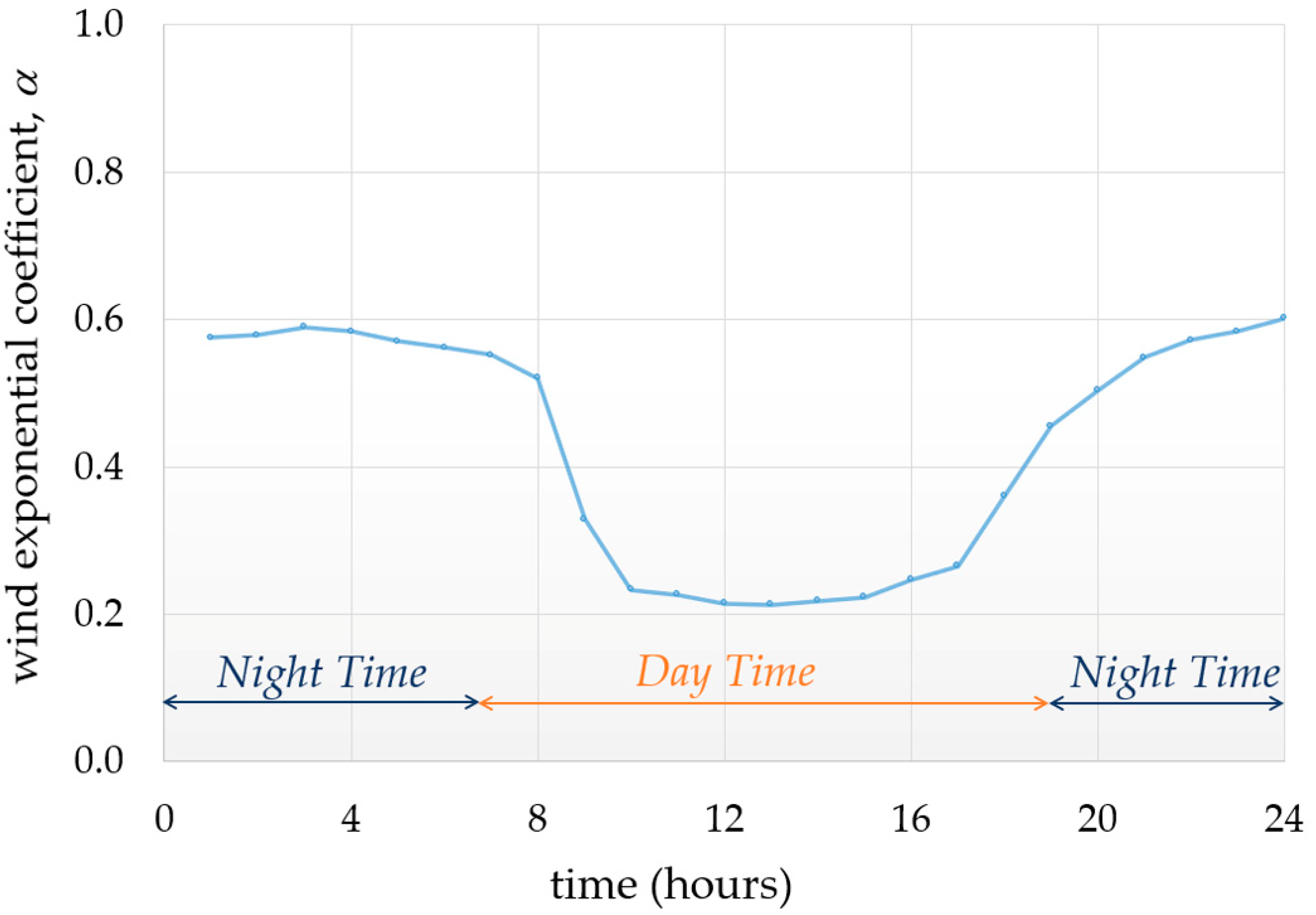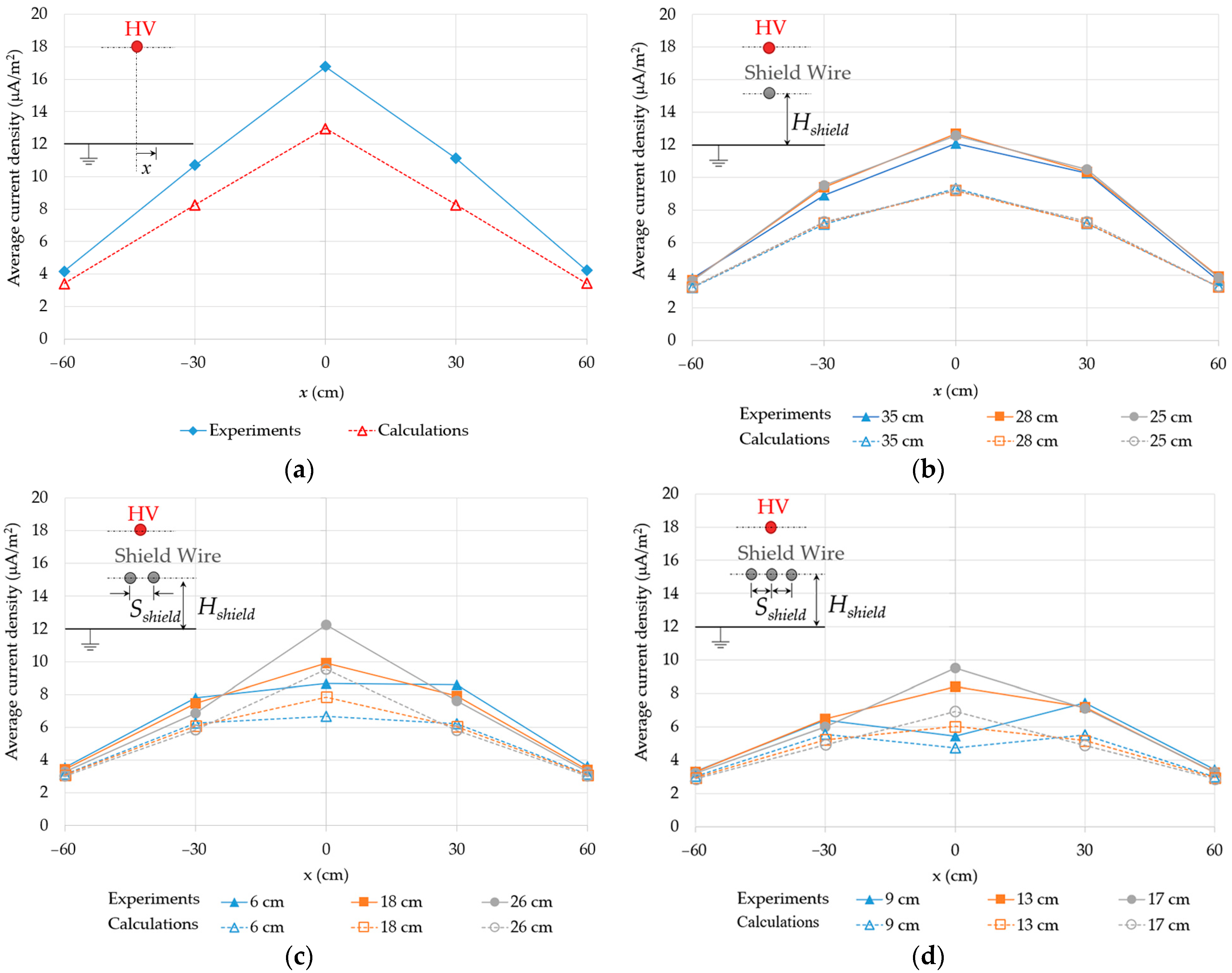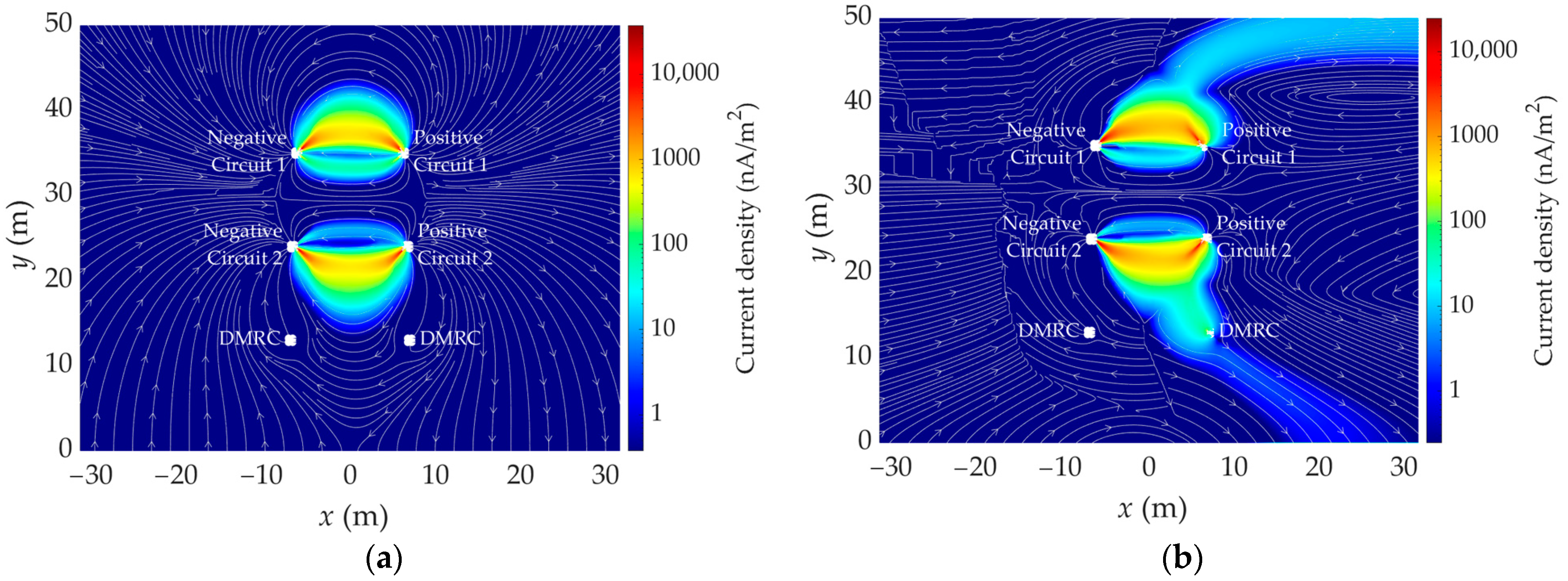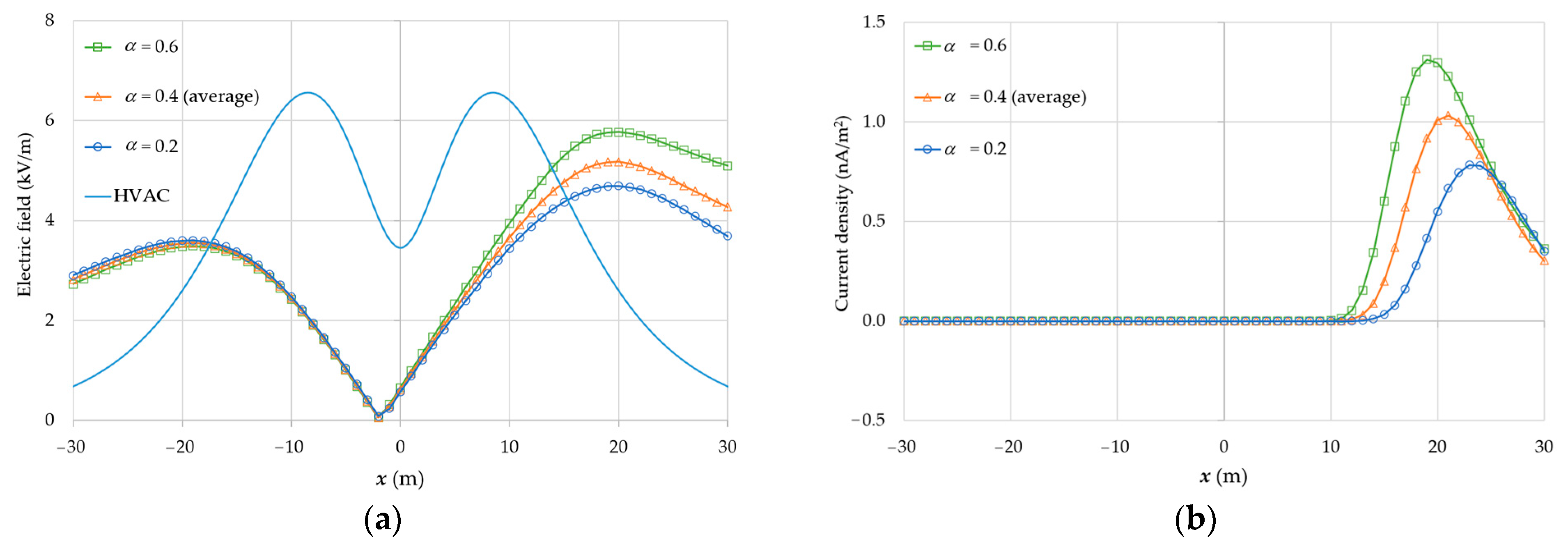Numerical Investigation on the Effects of Wind and Shielding Conductor on the Ion Flow Fields of HVDC Transmission Lines
Abstract
:1. Introduction
2. Methodology
2.1. Ion Flow Field Equations
2.2. Wind Profiles
2.3. Charge Initialization
3. Configurations and Boundary Conditions
4. Simulation
4.1. Space Charge Initialization
4.2. Ground Zone
4.3. Calculation Procedures
- If on the conductor surface exceeds the corona-onset electric field in Equation (9), the initial charge density from Equation (11) is added to the ionization zone.
- Equation (10) is used to calculate the space charge transportation and the solution of Poisson’s equation.
- In the ionization zone, the charge density is updated using Equation (12).
5. Experiments
6. Results and Discussion
6.1. Reduced Scale Configuration
6.2. Full Scale Configuration of ±250 kV Lines
6.3. 500. kV Full-Scale Configuration
6.3.1. In the Absence of Wind
6.3.2. In the Presence of Wind
6.3.3. Variation with Wind Parameters
7. Conclusions
Author Contributions
Funding
Data Availability Statement
Acknowledgments
Conflicts of Interest
References
- Hara, M.; Hayashi, N.; Shiotsuki, K.; Akazaki, M. Influence of wind and conductor potential on distributions of electric field and ion current density at ground level in DC high voltage line to plane geometry. IEEE Trans. Power Appar. Syst. 1982, PAS-101, 803–814. [Google Scholar] [CrossRef]
- Takuma, T.; Kawamoto, T. A very stable calculation method for ion flow field of HVDC transmission lines. IEEE. Trans. Power Deliv. 1987, 2, 189–198. [Google Scholar] [CrossRef]
- Maruvada, P.S. Influence of Wind on the Electric Field and Ion Current Environment of HVDC Transmission Lines. IEEE. Trans. Power Deliv. 2014, 29, 2561–2569. [Google Scholar] [CrossRef]
- Yi, Y.; Zhang, C.; Wang, L.; Chen, Z. Statistical evaluation and numerical analysis of effect of transverse wind on ionized field of ±800 kV UHVDC operating transmission lines. Electr. Power Syst. Res. 2016, 140, 560–567. [Google Scholar] [CrossRef]
- Yi, Y.; Chen, Z.; Tang, W.; Wang, L. Predictive calculation of ion current environment of dc transmission line based on ionised flow model of embedded short-term wind speed. IET Gener. Transm. Distrib. 2018, 12, 3837–3843. [Google Scholar] [CrossRef]
- Yi, Y.; Wang, L.; Chen, Z. Estimating the environmental impacts of HVDC and UHVDC lines for large-scale wind power transmission considering height-dependent wind and atmospheric stability. Int. J. Electr. Power Energy Syst. 2022, 138, 107868. [Google Scholar] [CrossRef]
- Yin, H.; Zhang, B.; He, J.; Wang, W. Restriction of ion-flow field under HVDC transmission line by installing shield wire. IEEE. Trans. Power Deliv. 2013, 28, 1890–1898. [Google Scholar] [CrossRef]
- Tian, F.; Zhanqing, Y.; Zeng, R.; Yin, H.; Zhang, B.; Liu, L.; Li, M.; Li, R.; He, J. Resultant electric field reduction with shielding wires under bipolar HVDC transmission lines. IEEE. Trans. Magn. 2014, 50, 221–224. [Google Scholar] [CrossRef]
- Noosuk, A.; Mermork, T.; Semjan, A.; Rahman, M.S.; Dawood, A.R.; Ismail, S.B.; Kurth, R.D.; Atmuri, S.R. Commissioning experience of the 300 MW Thailand-Malaysia interconnection project. In Proceedings of the IEEE/PES Transmission and Distribution Conference and Exhibition, Yokohama, Japan, 6–10 October 2002; Volume 2, pp. 1004–1009. [Google Scholar]
- CIGRE Working Group B2. 41. Guide to the Conversion of Existing AC Lines to DC Operation; Technical Brochure No. 583; CIGRE-International Council on Large Electric Systems: Paris, France, 2014; pp. 8–19. [Google Scholar]
- Lattarulo, F.; Amoruso, V. Filamentary Ion Flow: Theory and Experiments, 1st ed.; Wiley-IEEE Press: Hoboken, NJ, USA, 2014; pp. 25–61. [Google Scholar]
- Manwell, J.F.; McGowan, J.G.; Rogers, A.L. Wind Energy Explained: Theory, Design and Application, 2nd ed.; John Wiley & Sons: Chichester, UK, 2010; pp. 43–52. [Google Scholar]
- Mega, O.; Kasemsan, M.; Thayukorn, P. Wind Shear Coefficient at 23 Wind Monitoring Towers in Thailand. J. Sustain. Energy Environ. 2015, 6, 61–66. [Google Scholar]
- Maruvada, P.S. Corona Performance of High-Voltage Transmission Lines, 1st ed.; Research Studies Press Ltd.: Baldock, UK, 2000; pp. 82–86. [Google Scholar]
- Versteeg, H.; Malalasekera, W. An Introduction to Computational Fluid Dynamics: The Finite Volume Method, 2nd ed.; Pearson Education Limited: Harlow, UK, 2007; pp. 1–39. [Google Scholar]
- Yin, H.; He, J.; Zhang, B.; Zeng, R. Finite Volume-Based Approach for the Hybrid Ion-Flow Field of UHVAC and UHVDC Transmission Lines in Parallel. IEEE. Trans. Power Deliv. 2011, 26, 2809–2820. [Google Scholar] [CrossRef]
- Choopum, C.; Techaumnat, B. Investigation of the Effects of Ion Diffusivity on the Ion Flow Field Simulation. In Proceedings of the 19th Electrical Engineering/Electronics, Computer, Telecommunications and Information Technology (ECTI-CON), Prachuap Khiri Khan, Thailand, 24–27 May 2022; pp. 1–5. [Google Scholar]
- Fang, C.; Cui, X.; Zhou, X.; Lu, T.; Zhen, Y.; Li, X. Impact Factors in Measurements of Ion-Current Density Produced by High-Voltage DC Wire’s Corona. IEEE. Trans. Power Deliv. 2013, 28, 1414–1422. [Google Scholar] [CrossRef]











| Configurations | Line Voltage (kV) | (m) | (cm) | Number of Conductors |
|---|---|---|---|---|
| Reduced scale | +70 | 0.648 | 0.09 | 1 |
| Full scale | ±250 | 10 | 1.0 | 1 |
| ±500 | 35 (circuit no.1) 24 (circuit no.2) | 1.695 | 4 |
| k | |||
|---|---|---|---|
| 1 | |||
| 2 | |||
| 3 | N/A |
Disclaimer/Publisher’s Note: The statements, opinions and data contained in all publications are solely those of the individual author(s) and contributor(s) and not of MDPI and/or the editor(s). MDPI and/or the editor(s) disclaim responsibility for any injury to people or property resulting from any ideas, methods, instructions or products referred to in the content. |
© 2022 by the authors. Licensee MDPI, Basel, Switzerland. This article is an open access article distributed under the terms and conditions of the Creative Commons Attribution (CC BY) license (https://creativecommons.org/licenses/by/4.0/).
Share and Cite
Choopum, C.; Techaumnat, B. Numerical Investigation on the Effects of Wind and Shielding Conductor on the Ion Flow Fields of HVDC Transmission Lines. Energies 2023, 16, 198. https://doi.org/10.3390/en16010198
Choopum C, Techaumnat B. Numerical Investigation on the Effects of Wind and Shielding Conductor on the Ion Flow Fields of HVDC Transmission Lines. Energies. 2023; 16(1):198. https://doi.org/10.3390/en16010198
Chicago/Turabian StyleChoopum, Cattareya, and Boonchai Techaumnat. 2023. "Numerical Investigation on the Effects of Wind and Shielding Conductor on the Ion Flow Fields of HVDC Transmission Lines" Energies 16, no. 1: 198. https://doi.org/10.3390/en16010198




